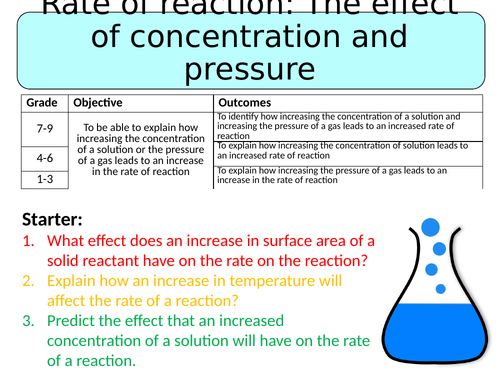
This lesson is designed for the NEW AQA Trilogy Chemistry GCSE, particularly the ‘Rates of Reaction’ SoW.
For more lessons designed to meet specification points for the NEW AQA Trilogy specifications for Biology, Chemistry and Physics please see my shop: https://www.tes.com/teaching-resources/shop/SWiftScience
The lesson begins with students introduced to the idea of concentration in terms of no. of particles per cm3. Students will then need to ‘Think > Pair > Share’ their ideas of how an increase in concentration may affect the rate of a reaction.
Students can use their ideas from this first task to make a prediction for the investigation into the rate of reaction between sodium thiosulphate and different concentrations of HCl. Students will need to conduct this investigation using the practical sheet provided, record their results, plot a graph of their results and complete a conclusion. Students can assess their explanation of the results they collected using the answer provided in the PowerPoint presentation.
The next part of the lesson will focus on the effect of pressure on the rate of a reaction. Students will firstly be introduced to the idea of an increasing pressure leading to an increase in the number of particles per cm3, using this information and the diagrams provided pupils can ‘Think > Pair > Share’ their ideas about how an increase in pressure would affect the rate of a reaction. Their answer to this question can self-assessed using the answers provided.
Next, students need to work through a set of levelled questions on the effect of pressure on the rate of a reaction. This work can be self-assessed using the answers provided on the PowerPoint.
The last task is for pupils to plot a set of results onto graph paper, using these data they can calculate the initial rate of reactions for two concentrations of HCl. Students can assess their work using the mark scheme provided on the PowerPoint.
The plenary task is for pupils to write down three quiz questions (and the answers!) to test their peers knowledge of what they have learned in the lesson.
All resources are included at the end of the presentation. Thanks for looking, if you have any questions please let me know in the comments section and any feedback would be appreciated :)
Get this resource as part of a bundle and save up to 44%
A bundle is a package of resources grouped together to teach a particular topic, or a series of lessons, in one place.
Something went wrong, please try again later.
Fantastic Resourse
Report this resourceto let us know if it violates our terms and conditions.
Our customer service team will review your report and will be in touch.
